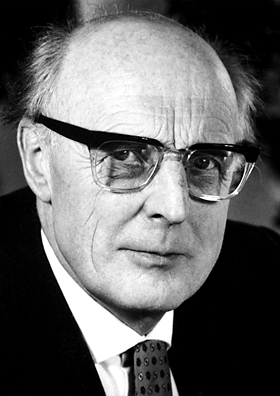J. Hans D. Jensen facts for kids
Quick facts for kids
J. Hans D. Jensen
|
|
|---|---|
 |
|
| Born |
Johannes Hans Daniel Jensen
25 June 1907 |
| Died | 11 February 1973 (aged 65) |
| Nationality | German |
| Alma mater | University of Hamburg |
| Awards | Nobel Prize in Physics (1963) |
| Scientific career | |
| Fields | Physics |
| Doctoral advisor | Wilhelm Lenz |
| Doctoral students | Hans-Arwed Weidenmüller |
Johannes Hans Daniel Jensen (born June 25, 1907 – died February 11, 1973) was a German nuclear physicist. He was a very important scientist. He won the Nobel Prize in Physics in 1963. He shared this prize with Maria Goeppert-Mayer. They won for their idea of the nuclear shell model. This model helps us understand how the tiny parts inside an atom's nucleus are arranged.
During World War II, Jensen worked on a German project. It was called the Uranium Club. His job was to help separate different types of uranium isotopes. This was important for understanding nuclear energy. After the war, he became a professor at the University of Heidelberg. He also visited many universities in the United States.
Contents
Jensen's Education
Jensen studied physics, math, chemistry, and philosophy. He went to the University of Freiburg and the University of Hamburg. He studied there from 1926 to 1931. In 1932, he earned his doctorate degree from the University of Hamburg. His teacher was Wilhelm Lenz. He finished his "habilitation" in 1936. This is a special qualification needed to teach at a German university.
Jensen's Career and Discoveries
In 1937, Jensen became a lecturer at the University of Hamburg. He started working with Paul Harteck. Harteck was a chemistry professor. He also advised the German Army on explosives.
On September 1, 1939, World War II began. The German Army took control of the Uranium Club. Harteck, a key person in this project, brought Jensen into it. Jensen's main work was on special machines called centrifuges. These machines were used to separate different types of uranium for nuclear research. Harteck and Jensen worked together to make these centrifuges better.
In 1941, Jensen became a professor at the Technische Hochschule Hannover. After the war, in 1946, he became a full professor there. In 1949, he moved to the University of Heidelberg as a professor. He also spent time as a visiting professor at several universities in the United States. These included the University of Wisconsin–Madison, the Institute for Advanced Study, and the University of California, Berkeley.
In 1963, Jensen shared half of the Nobel Prize in Physics with Maria Goeppert-Mayer. They received the award for their idea of the nuclear shell model. This model explains how protons and neutrons are arranged in layers inside the nucleus of an atom. The other half of the prize went to Eugene Wigner for different work in physics.
Joining Organizations During World War II
When Adolf Hitler came to power in Germany in 1933, the education system changed. New laws and rules made it necessary for people in universities to be part of certain political groups. These groups were linked to the Nazi Party. While joining these groups was not always required, it was often helpful for a scientist's career. It could make it easier to get a teaching job at a university.
Jensen joined some of these groups. He became a member of the National Socialist German University Lecturers League. He also joined the National Socialist Teachers League. In 1937, he became a candidate for membership in the Nazi Party itself. The University of Hamburg, where Jensen worked, was very strict about these rules. They expected active participation from their staff.
After World War II, Germany went through a process called "denazification." This was to remove people who had supported the Nazi Party from important positions. Jensen faced this process. He asked Werner Heisenberg, another famous physicist, to write a letter for him. This letter, sometimes called a "whitewash certificate," helped explain his situation. Heisenberg wrote that Jensen had joined the Party groups only to avoid problems in his academic career. This helped Jensen continue his work as a scientist.
Awards and Honors
Johannes Hans Daniel Jensen received many honors for his work:
- 1947 – He became an honorary professor at the University of Hamburg.
- 1963 – He won the Nobel Prize in Physics.
- 1964 – He received an honorary doctorate from the Technische Universität Hannover.
- 1969 – He was made an honorary citizen of Fort Lauderdale, Florida.
See also
 In Spanish: J. Hans D. Jensen para niños
In Spanish: J. Hans D. Jensen para niños

